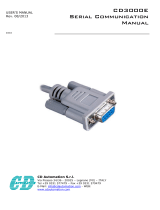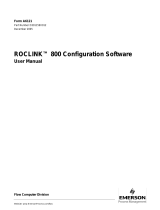
GRAPHICS RECORDER/DATA ACQUISITION AND LOGGING UNIT COMMUNICATIONS MANUAL
HA028122
Issue 5 Nov 04
Comms
Page 5
3 MODBUS MASTER COMMS................................................................. 68
3.1 INTRODUCTION.......................................................................................... 68
3.2 MASTER COMMS CONFIGURATION MENU ................................................. 69
3.2.1 Configurable parameters ...................................................................... 69
DETECT THIS SLAVE ............................................................................. 70
DETECT ALL SLAVES ............................................................................. 71
SHARE SOCKET .................................................................................. 72
3.3 MASTER COMMS CHANNEL CONFIGURATION ........................................... 73
3.3.1 Recorder/Data acquisition unit configurable parameters.......................... 73
TYPICAL RECORDER PARAMETERS ........................................................ 74
3.3.2 Controller parameters........................................................................... 75
TYPICAL CONTROLLER PARAMETERS .................................................... 76
3.3.3 User defined registers............................................................................ 77
CONFIGURABLE PARAMETERS ............................................................. 77
3.3.4 Reading digital values .......................................................................... 79
OPEN/CLOSED STRINGS .................................................................... 79
STATUS BITS ........................................................................................ 79
3.4 Demand Write Configuration ........................................................................ 81
3.4.1 Writing to a known recorder ................................................................. 81
CONFIGURABLE ITEMS........................................................................ 82
DEMAND WRITE BUTTON ................................................................... 82
3.4.2 Writing to a specific register ................................................................. 83
CONFIGURABLE PARAMETERS ............................................................. 83
DEMAND WRITES WITH AUDIT TRAIL ................................................... 84
3.5 OUTPUT CHANNELS.................................................................................... 85
3.5.1 Configurable parameters ...................................................................... 85
3.6 MASTER COMMS CHANNEL CONFIGURATION EXAMPLE ............................. 86
3.6.1 Example.............................................................................................. 86
3.6.2 Master channel 1 setup ........................................................................ 87
3.6.3 Master channel 2 setup ........................................................................ 88
3.6.4 Master Output 1 setup.......................................................................... 89
3.6.5 Slave Input Channel 1 setup.................................................................. 89
3.7 MASTER COMMS DIAGNOSTICS ................................................................. 90
4 SERIAL COMMUNICATIONS OPTION .................................................. 91
4.1 INTRODUCTION.......................................................................................... 91
4.1.1 ASCII (input)........................................................................................ 91
4.1.2 MODBUS RTU ..................................................................................... 91
4.2 INSTALLATION............................................................................................. 91
4.2.1 Installation rules: .................................................................................. 92
4.2.2 Termination and biassing (Not EIA232).................................................. 92
4.3 CONFIGURATION ....................................................................................... 93
4.3.1 Configuration parameters ..................................................................... 94
LINK ERROR COUNT ........................................................................... 94
SERIAL PORT ....................................................................................... 94
PROTOCOL......................................................................................... 94
BAUD RATE ......................................................................................... 94
STOP BITS........................................................................................... 94
PARITY ................................................................................................ 94
DATA BITS ........................................................................................... 94
TIMEOUT ............................................................................................ 94
MESSAGE START/END CHARACTERS ................................................... 94
GROUP SELECTION............................................................................. 94
ENABLE ERROR CODE B ...................................................................... 95
ENABLE TALK THROUGH ..................................................................... 95
4.4 MESSAGING INFORMATION....................................................................... 95
4.4.1 Messaging Rules .................................................................................. 95
LIST OF CONTENTS (CONT.)
Section Page






















